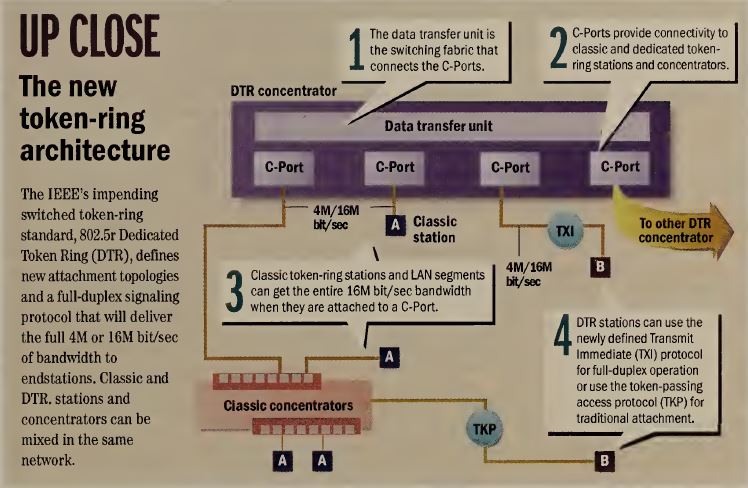New token-ring standard
to boost bandwidth
New token-ring standard to boost bandwidth Network World, Page 31 Feb 5, 1996
By Robert Love
Although most token-ring networks operate well below capacity, the day will soon come when applications push them to their limit. Never fear, the IEEE 802.5 committee already found a way to deliver a substantial performance increase while maintaining compatibility with the installed base.

Its answer lies in the impending switched token-ring standard, called 802.5r Dedicated Token Ring (DTR). The DTR standard defines requirements for new endstations and concentrators, and it specifies a protocol for full-duplex operation. All will coexist with existing token-ring equipment and the token-passing access protocol.
The DTR concentrator consists of C-Ports and a data transfer unit (DTU). The C-Ports provide the basic connectivity from the device to token-ring stations, classic concentrators or other DTR concentrators. The DTU is the switching fabric that connects the C-Ports within a DTR concentrator. In addition, DTR concentrators can be linked to each other over a LAN or WAN via data transfer services such as Asynchronous Transfer Mode.
A LAN segment on a classic concentrator can be linked to the rest of the network by attaching a DTR C-Port (operating in station-emulation mode) to any available lobe on the device. This small segment is then given the entire 16M bit/sec token-ring bandwidth.
DTR-enabled endstations will operate identically to existing token-ring stations when attached to a classic concentrator. Using the new access protocol, called Transmit Immediate (TXI), they also can operate in full-duplex mode when attached to a DTR concentrator.
Migration to DTR
Bringing DTR equipment into an existing token-ring environment will pump up the amount of available bandwidth. Consider a 16M bit/sec token-ring network that provides each of 80 stations with an average bandwidth of 20K bit/sec. You can gain an eightfold increase in capacity, to 128M bit/sec, by dividing the network into eight token-ring segments and connecting each one to a DTR concentrator port.
In this scenario, the average bandwidth for each endstation increases to 1.6M bit/sec without changing a single adapter or concentrator. Coupled with the priority capability inherent in the token-ring architecture, this bandwidth is more than sufficient for today’s high-band-width requirements and can handle time-critical multimedia applications.
Emerging data-intensive, video and collaborative computing applications will not tolerate the bandwidth or timing limitations of shared-media LANs. You can provide 16M bit/sec of dedicated bandwidth to existing token-ring stations by directly attaching them to DTR concentrator C-Ports. The combination of high bandwidth and 100% channel availability will make it feasible to handle these types of applications in a token-ring environment.
Long before your applications will require more than a dedicated 16M bit/sec channel, you will have replaced your end-stations with next-generation high-powered PCs and workstations. You would then populate these machines with DTR-enabled adapters so that when they are connected to a DTR concentrator port, they can run in full-duplex mode, providing up to 32M bit/sec of total available bandwidth to and from the station.
Since both full-duplex and classic token ring use standard token-ring frames, the application code that runs on classic token ring will run on DTR. This means you can migrate to DTR to improve your LAN’s performance without rewriting code or retraining users.
Status report
The IEEE 802.5 committee is currently finalizing the DTR standard. All major DTR implementors have been participating in its creation while developing products.
Following the advice and encouragement of the Alliance for Strategic Token Ring Advancement and Leadership (ASTRAL), an independent lab already has completed two rounds of interoperability testing on prototype products. The University of New Hampshire’s token-ring testing center conducted the tests. This early test program is unprecedented in standards development and provides a high level of confidence in the standard and initial DTR products. It has resulted in minor improvements to the draft standard and emerging DTR products.
As a result of this new standard from IEEE 802.5, you will see DTR-enabled adapters and concentrators early this year from virtually all of the major token-ring vendors. These products will have the benefit of early interoperability testing and of token ring’s outstanding reliability and network management to let you easily and confidently add the bandwidth needed for coming applications using token-ring switching technology.
Love is a senior engineer at IBM in Research Triangle Park, N.C., vice chairman of the IEEE 802.5 group and an active participant of ASTRAL. He can be reached at dlove@vnet.ibm.com.